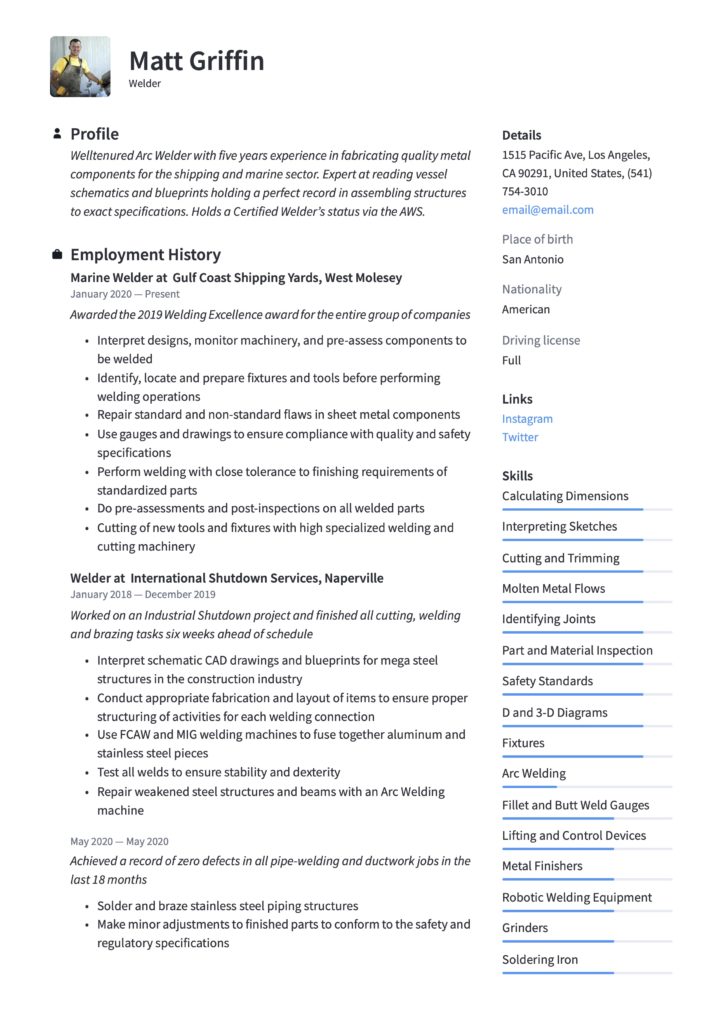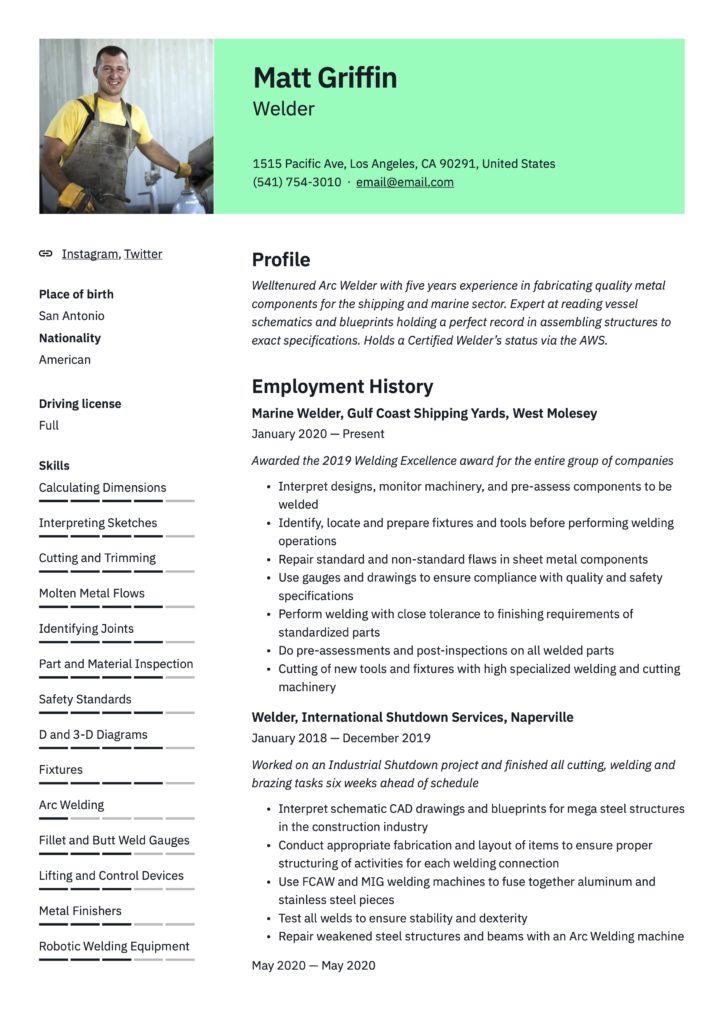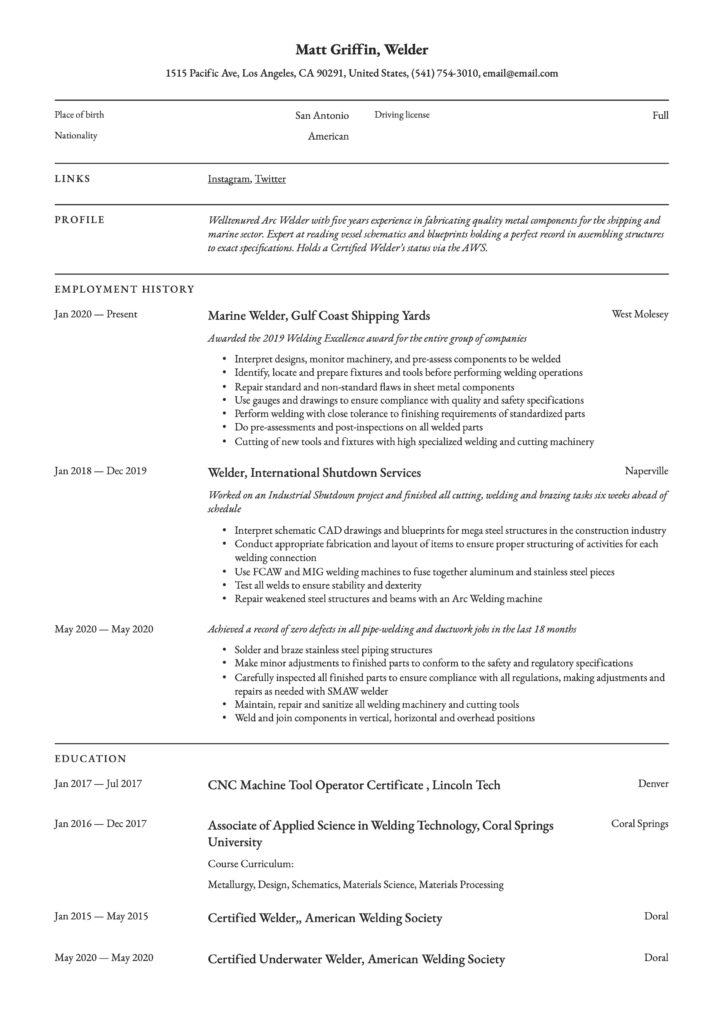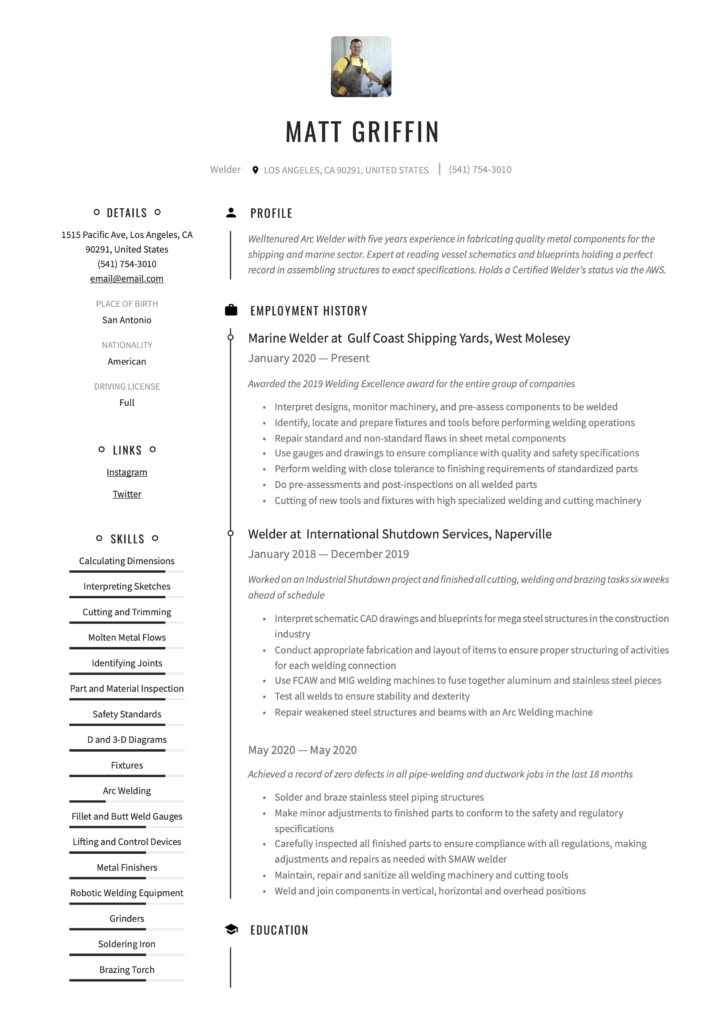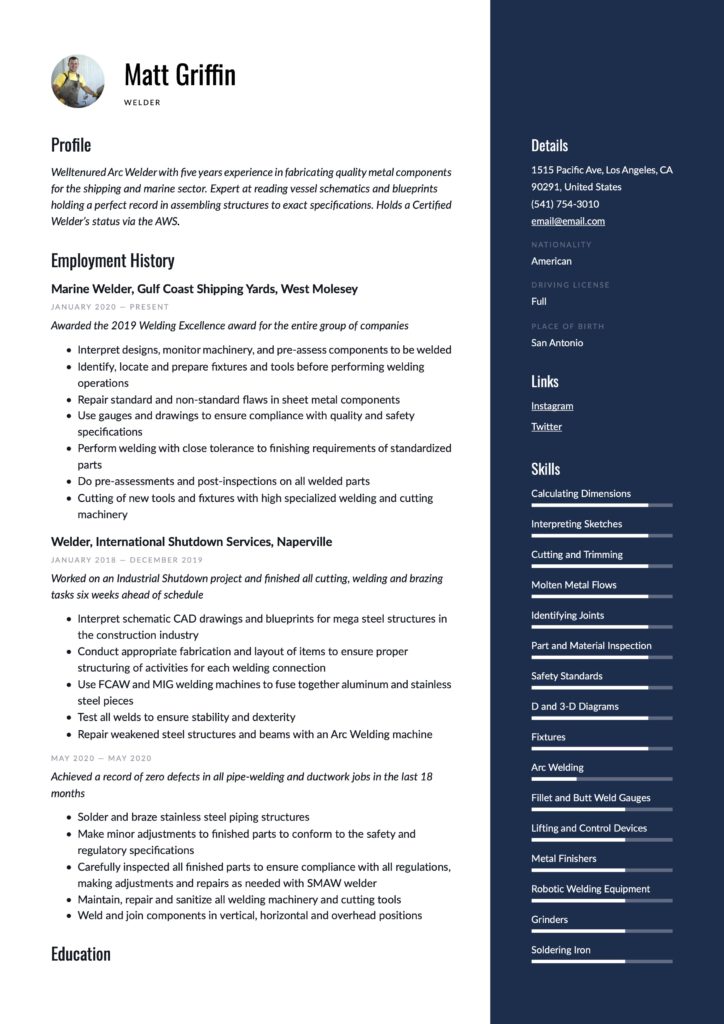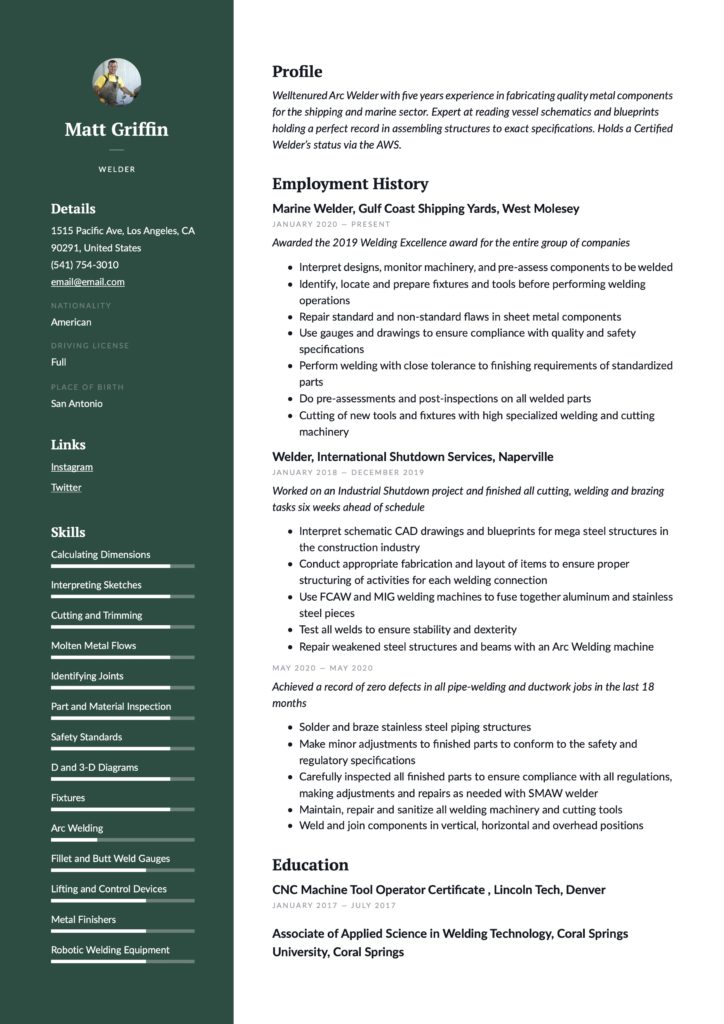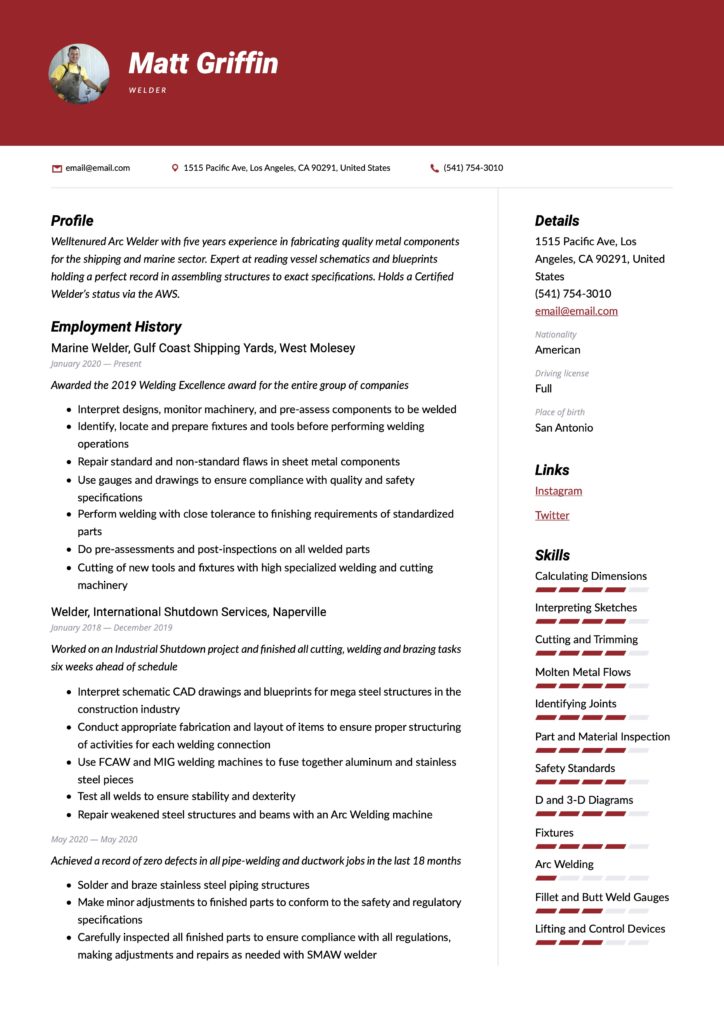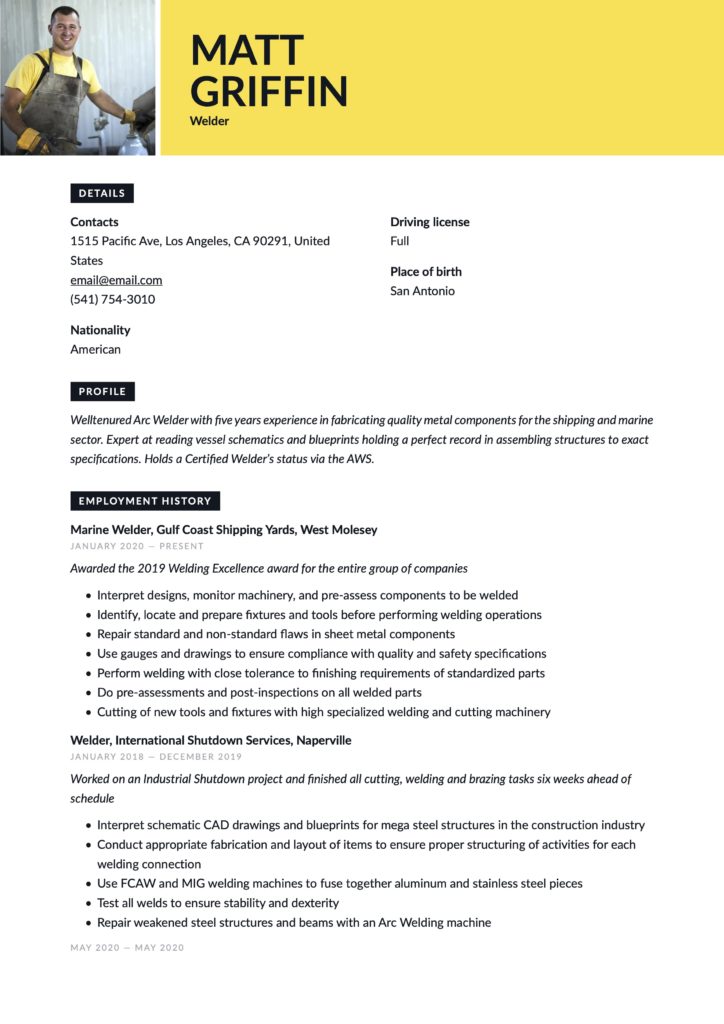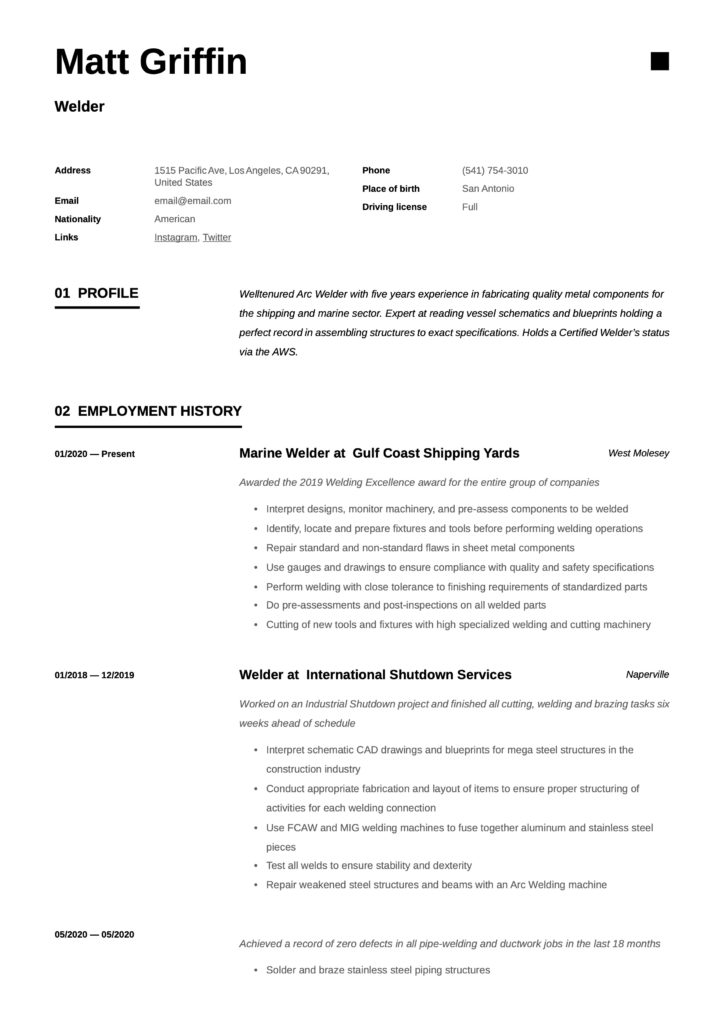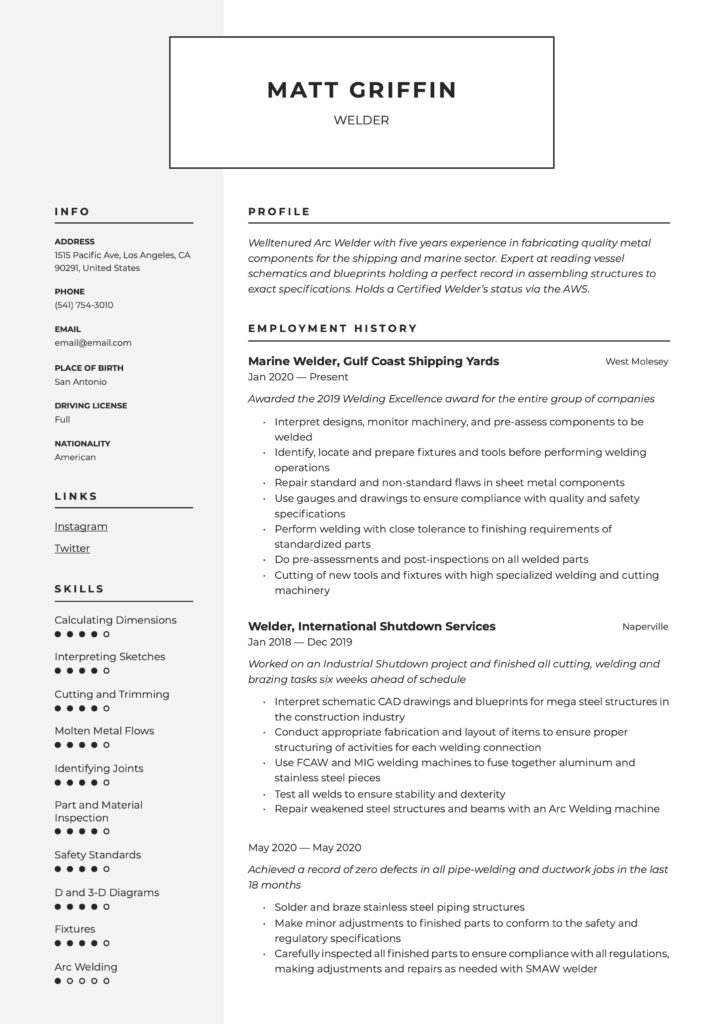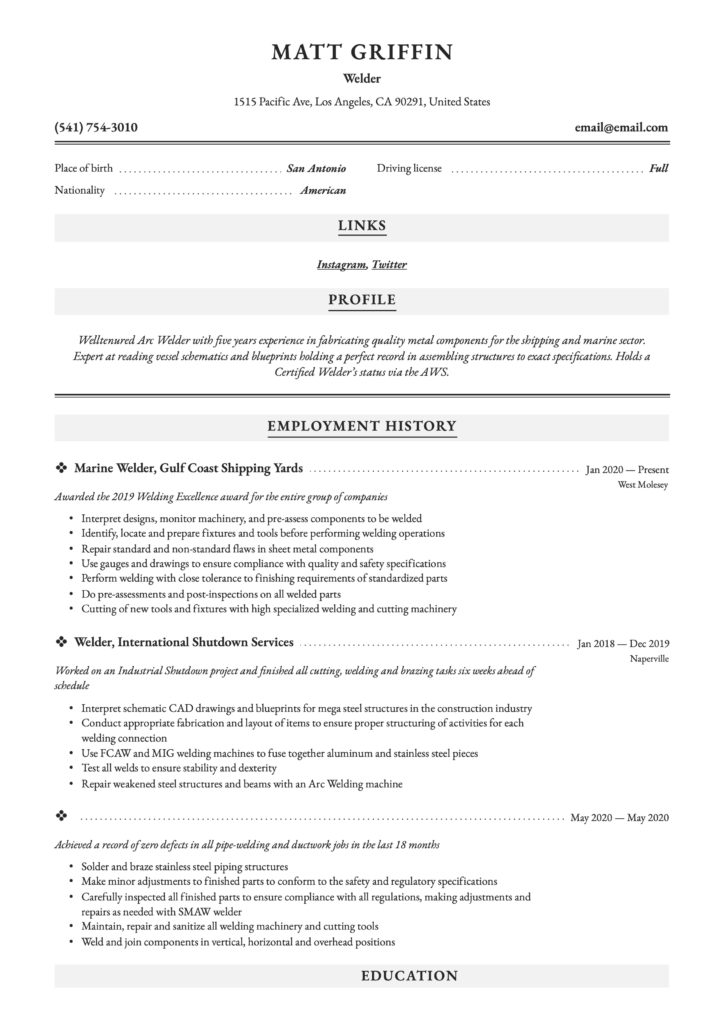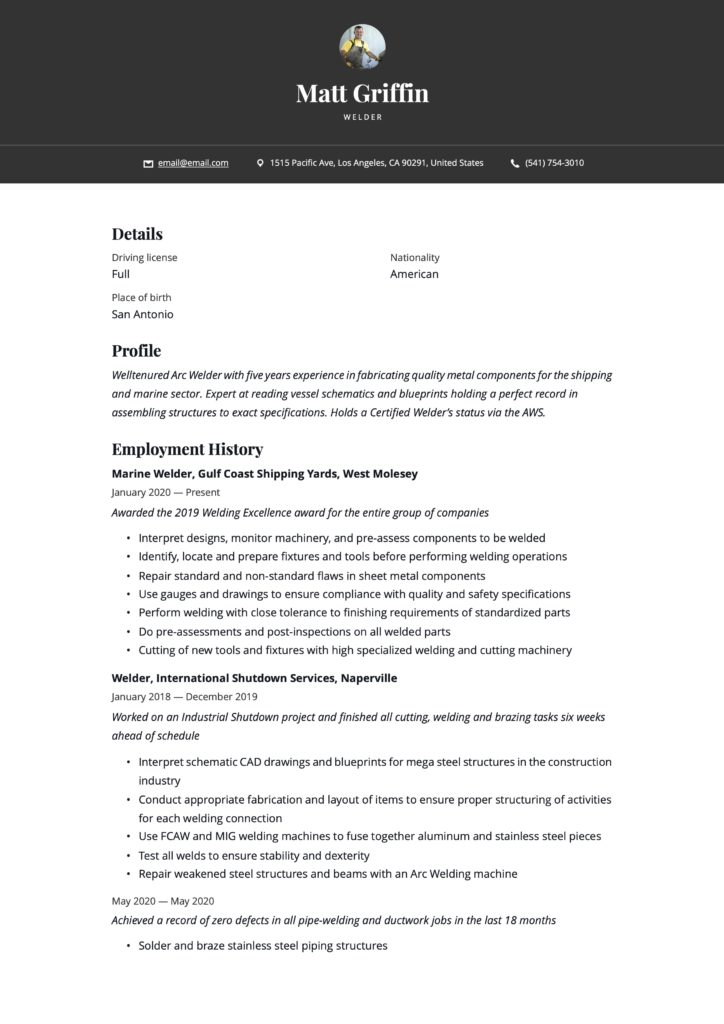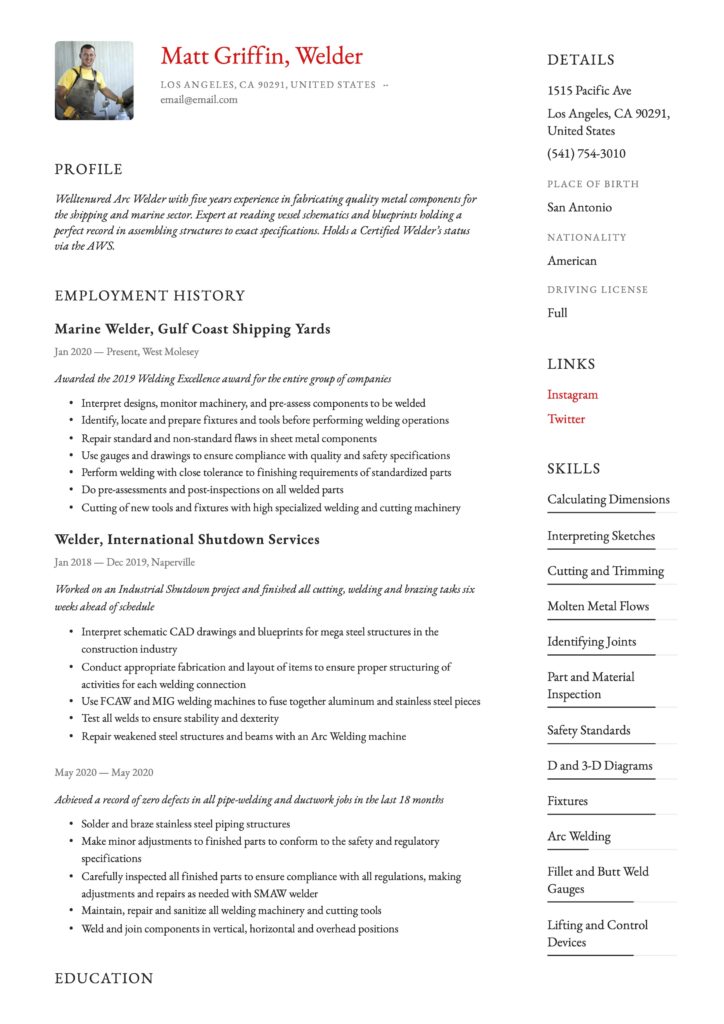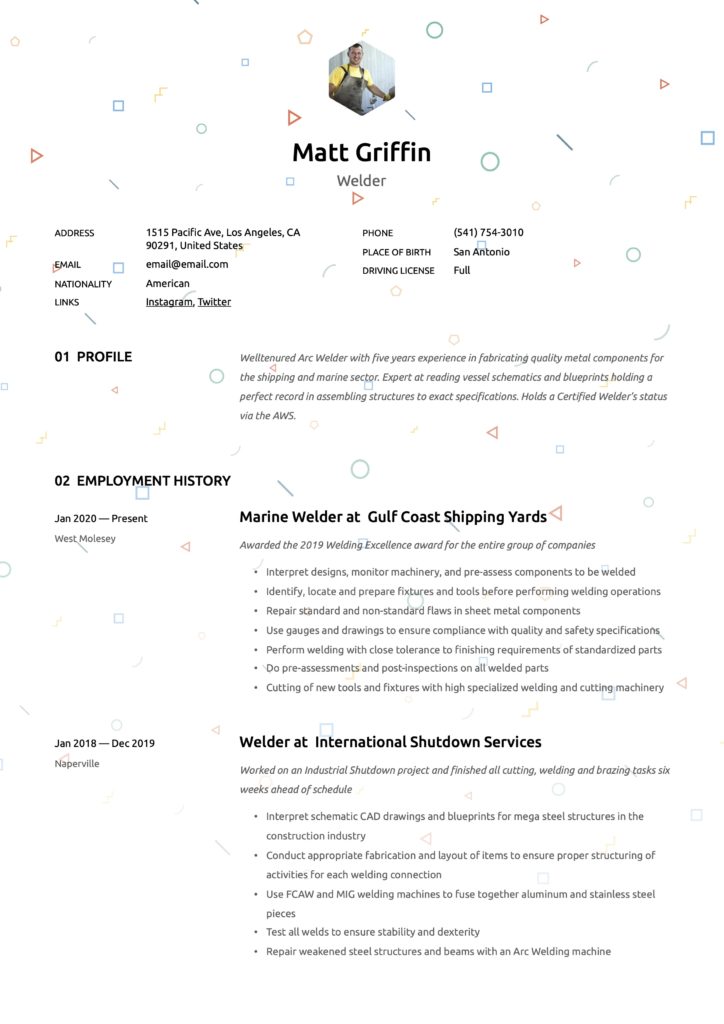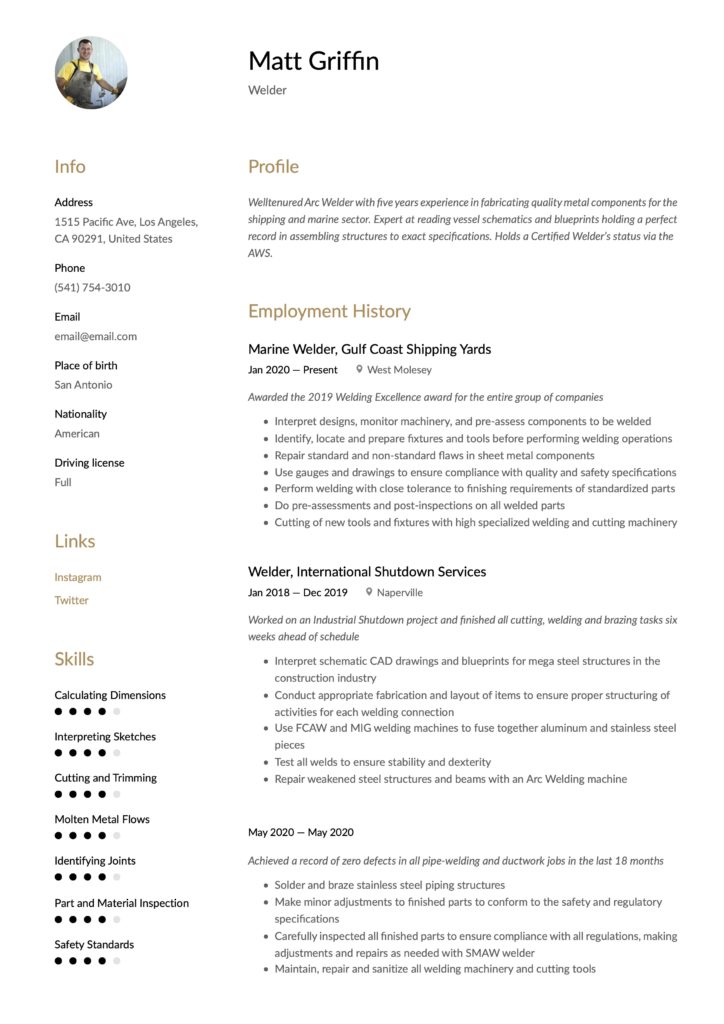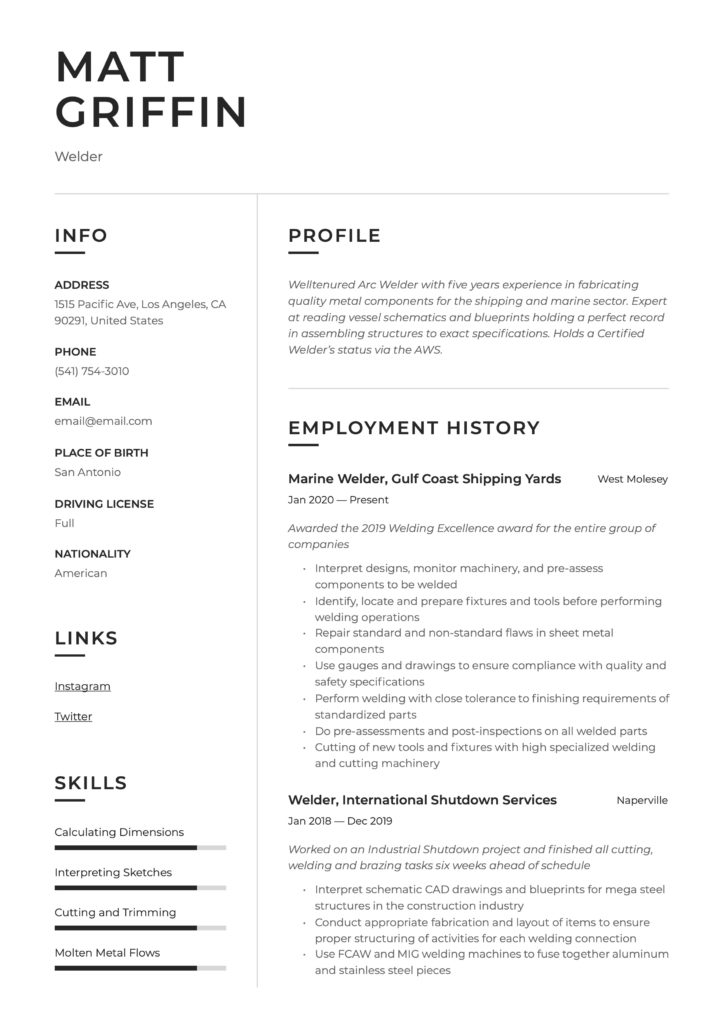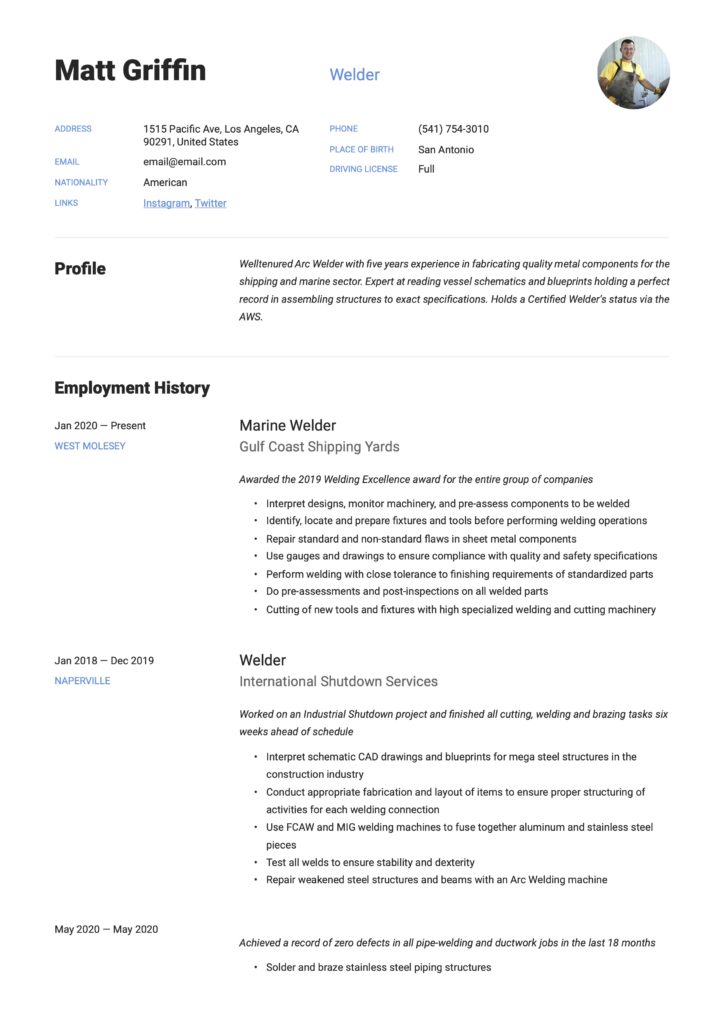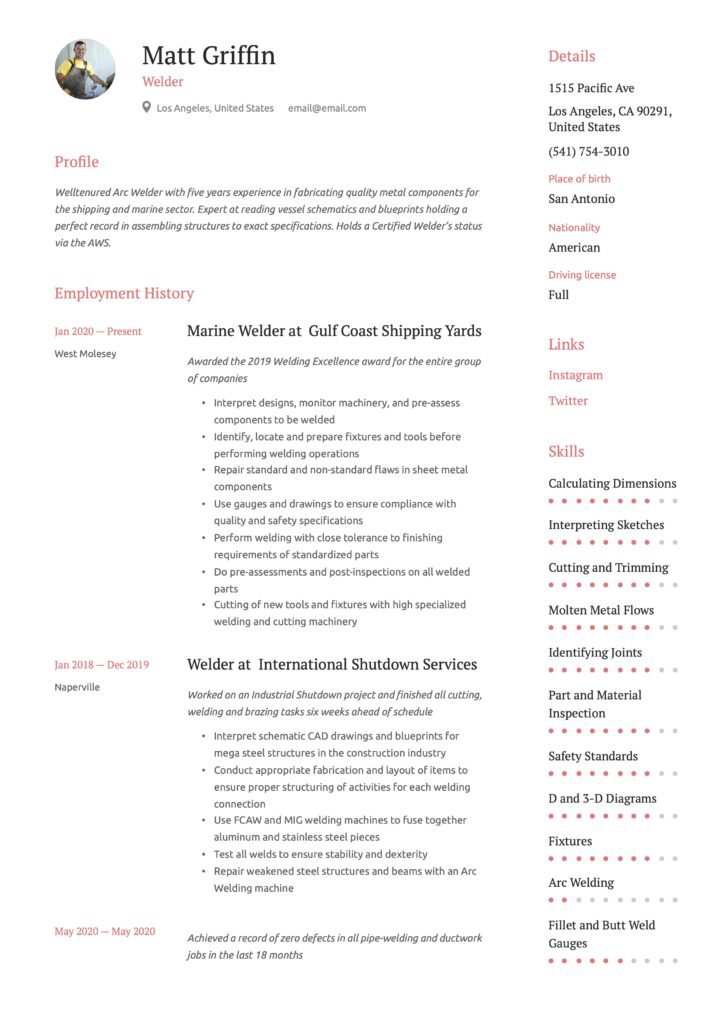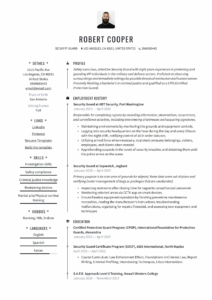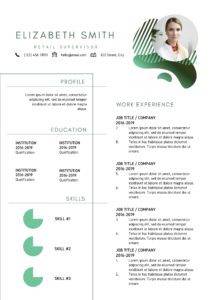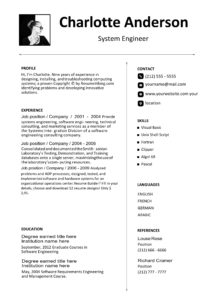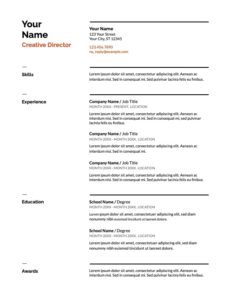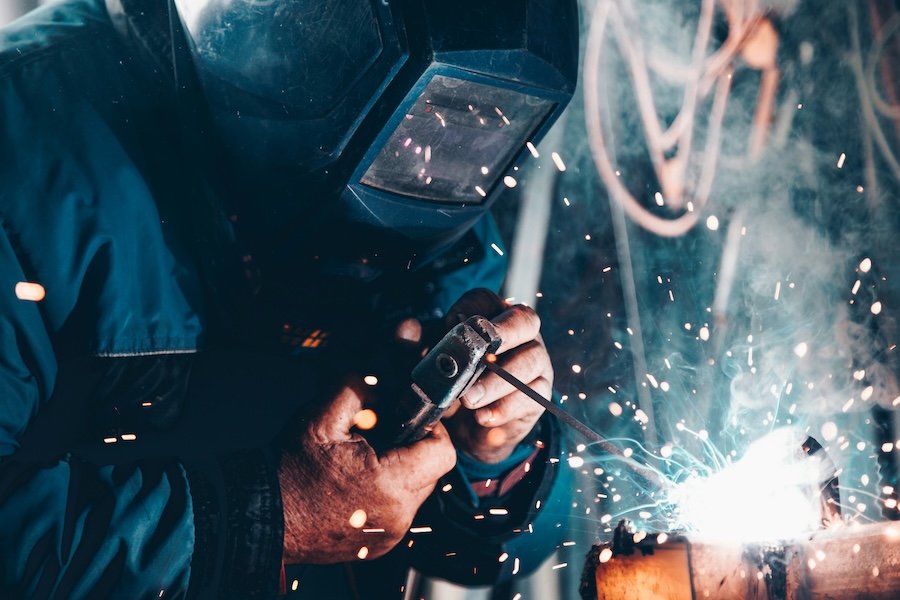
In today's competitive job market, having a standout resume is essential for landing your dream job as a welder. Your resume is your first impression on potential employers, and it's crucial to make it count. Crafting a welder resume that effectively showcases your skills, experience, and qualifications can significantly increase your chances of securing an interview and ultimately landing the job you desire. In this comprehensive guide, we'll walk you through the step-by-step process of creating a welder resume or CV that stands out from the crowd.
What you can read in this article
17 Welding Resume Samples
You can download all the resume samples in Pdf for free to use for your own resume writing.*
The Perfect Welder Resume: A Comprehensive Guide
Understanding the Role of a Welder
Before diving into the nitty-gritty of resume writing, it's essential to fully understand the role of a welder. Welders are skilled tradespeople responsible for joining metal parts together using various welding techniques. They work in a wide range of industries, including manufacturing, construction, automotive, and aerospace. Welders must possess a strong attention to detail, excellent hand-eye coordination, and the ability to interpret blueprints and technical drawings accurately.
Formatting Your Welder Resume
The format of your welder resume plays a crucial role in grabbing the attention of potential employers. When formatting your resume, keep it clean, organized, and easy to read. Start with a clear and concise resume header containing your name, contact information, and professional title (e.g., Certified Welder). Use a legible font and maintain a consistent resume format throughout.
Key Sections to Include
- Cotact Details: Essential information to have on your resume
- Resume Objective: A brief overview of your professional background, skills, and career objectives.
- Work Experience: Detail your relevant work experience, including job titles, dates of employment, and key responsibilities.
- Education: List any relevant education and training, including welding certifications and vocational programs.
- Certifications: Include any relevant welding certifications or licenses you hold, such as AWS Certified Welder or ASME Welding Inspector.
- Skills: Highlight your technical skills, including proficiency in various welding techniques, equipment operation, and safety protocols.
- Additional Sections: Consider including sections for awards, achievements, or professional affiliations to further showcase your qualifications.
First: Your Contact Information & details
We begin by stating our contact details on our resume or cv. The most expected details are:
- Name
- Address
- Phone
Now you could add extra's to you liking, such as your date of birth, a drivers' license, a photo, a place of birth and your nationality.
Welder Resume Objectives
The resume objective is fulfilling a dual purpose in your welding resume. Firstly, it provides a clear outline of what to expect in the rest of the resume content regarding your qualifications, experience, and specialist skills.
Secondly, it is a helpful tool for inpatient hiring managers who only have to skim through resume objectives before making shortlisting decisions. The crux of the matter, it has to be remarkable.
Attention!: Try to write your objective profile after finishing the rest of your resume, because by then your thoughts would be more structured on issues such as most important skills, specialist experience, and prominent personality traits.
Now if you are ready to write your resume objective:
Stick to one paragraph and highlight three aspects: industry experience, specialist skills, and certifications
Example Welder Resume Objectives:
Objective Example 1:
“Well-tenured Arc Welder with five years experience in fabricating quality metal components for the shipping and marine sector. Expert at reading vessel schematics and blueprints, holding a perfect record in assembling structures to exact specifications. Holds a Certified Welder’s status via the AWS.“
Objective Example 2:
“Certified Precision Welder with 8+ years of experience in underwater welding and a Commercial Diving Certificate coupled with an Underwater Welding Certification. Skilled in over 30 welding processes and including SMAW, MIG, FCAW, and TIG. Member of American Welding Society since 2016.“
Objective Example 3:
“Recently certified, but exceptionally sharp welder with two years of expertise in all latest welding techniques and software applications such as SmartDraw, MITCalc-Welded Connections, and Weldshop. Welding certificate course graduate of 2024. Fluent in Spanish, English, and German.“
Resume Work History
Crafting an effective Work History section for your Welder resume is crucial in showcasing your relevant experience and skills to potential employers. Here's how you can structure and write this section:
- Start with Your Most Recent Position: Begin by listing your most recent job title, the name of the company or organization, and the dates of your employment. Use a reverse chronological order to highlight your career progression.
- Include Job Responsibilities: Provide a concise overview of your key responsibilities and duties in each role. Focus on tasks directly related to welding, such as interpreting blueprints, operating welding equipment, and performing quality inspections.
- Highlight Achievements: Quantify your achievements where possible, such as completing projects ahead of schedule, reducing material waste, or implementing safety improvements. This helps demonstrate your effectiveness and contributions as a welder.
- Showcase Relevant Skills: Highlight specific welding techniques, certifications, and specialized skills you utilized or acquired in each position. This could include proficiency in MIG welding, TIG welding, or experience with specific metals or alloys.
- Emphasize Teamwork and Collaboration: Mention any collaboration with colleagues, supervisors, or other departments to emphasize your ability to work effectively in a team environment. Welding often involves coordination with other trades and departments, so teamwork skills are highly valued.
- Tailor to the Job Description: Customize your Work History section to align with the requirements of the job you're applying for. Highlight experiences and achievements that directly relate to the position, demonstrating your suitability for the role.
Here's an example of how you can structure a Work History section for a Welder resume:
Work History:
Senior Welder XYZ Manufacturing Company, Anytown, USA January 2020 – Present
- Executed welding tasks according to project specifications, including fabricating structural components and welding various metals such as stainless steel and aluminum.
- Collaborated with engineering teams to interpret blueprints and ensure accurate welding procedures.
- Implemented efficiency improvements, resulting in a 15% reduction in production time and material waste.
- Mentored junior welders, providing guidance on welding techniques and safety protocols.
Welder Fabricator ABC Welding Services, Anytown, USA June 2016 – December 2019
- Conducted MIG and TIG welding operations on a variety of projects, including custom fabrication and repairs.
- Inspected welds for quality and compliance with industry standards, ensuring precision and accuracy.
- Received “Employee of the Month” award twice for exceptional productivity and attention to detail.
- Completed a specialized welding certification course in advanced aluminum welding techniques.
Customize this template with your own experiences, achievements, and skills to create a compelling Work History section for your welder cv document.
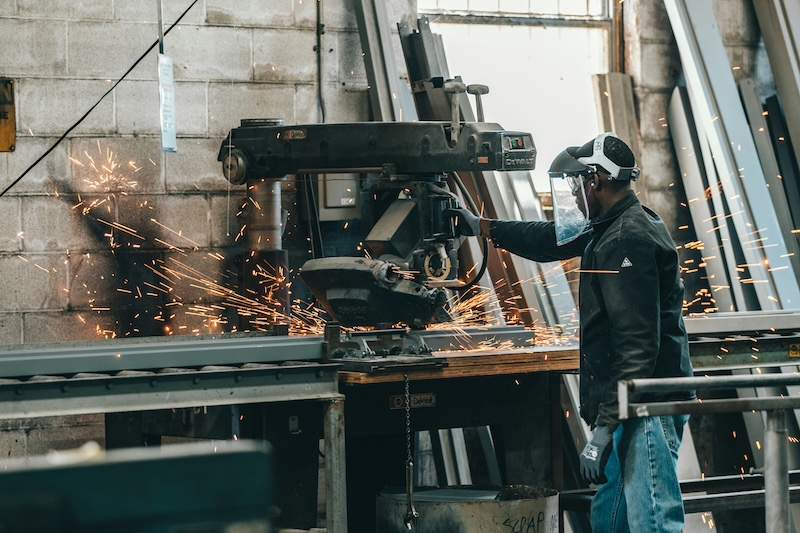
Welder Duties and Responsibilities
As we mentioned earlier, there are over 100 different welding processes used in the industry; therefore, your job description section should clearly define what your primary type of experience entails and the supporting activities that you do to fulfill the primary purpose of your job. In the article below, we offer you a comprehensive, but generic list of welding job duties to get you started in customizing your own unique job duty section.
Examples
Generic Welder Job Description:
- Interpret designs, monitor machinery, and pre-assess components to be welded
- Identify, locate and prepare fixtures and tools before performing welding operations
- Repair standard and non-standard flaws in sheet metal components
- Use gauges and drawings to ensure compliance with quality and safety specifications
- Perform welding with close tolerance to finishing requirements of standardized parts
- Do pre-assessments and post-inspections on all welded parts
- Cutting of new tools and fixtures with high specialized welding and cutting machinery
- Interpret schematic CAD drawings and blueprints for mega steel structures in the construction industry
- Conduct appropriate fabrication and layout of items to ensure proper structuring of activities for each welding connection
- Use FCAW and MIG welding machines to fuse aluminum and stainless-steel pieces
- Test all welds to ensure stability and dexterity
- Repair weakened steel structures and beams with an Arc Welding machine
- Solder and braze stainless-steel piping structures
- Make minor adjustments to finished parts to conform to the safety and regulatory specifications
- Carefully inspected all finished parts to ensure compliance with all regulations, making adjustments and repairs as needed with SMAW welder
- Maintain, repair and sanitize all welding machinery and cutting tools
- Weld and join components in vertical, horizontal and overhead positions
What to Highlight in Your Welding Resume?
Considering that welders can work in almost any industry and that there are more than 100 different welding processes a welder can use, there are specific points to highlight on your resume to gain the attention of recruiters.
First, provide context about your work setting. Welders can work full-time or part-time, and often work overtime. It would be good for recruiters to know upfront regarding your availability. In terms of your actual working environment, detail whether most of your welding activities are performed indoors, outdoors, on scaffolding, in a confined space, or involve hazardous environments. Also, indicate whether you are willing to relocate, as that will place you in the best situation to get higher-paying jobs.
Next, outline the scope of your role, which could be focussed on welding, soldering, cutting or brazing, and even combinations of each. Hiring managers would need to read about your physical activities that take up most of your day, for example, cutting metal parts, smoothing surfaces, analyzing schematics or molding, and softening steal with high-end machinery. Below is some verbiage for the main welding activities, which may help you to define the scope of your role clearly:
Pure Welding: Join materials such as metal and steel together with machinery that creates intense heat to soften the materials used.
Cutting: Involves large scale or micro-cutting with high-end machinery to either trip materials or dismantle large objects.
Soldering: Included precision forming to join materials in small-scale components like electronic circuit boards.
Brazing: Utilizes heated metals to apply coatings to other parts for protection against wear and corrosion.
Then it is time to explain the industry categories that you have experience in. Although most of the welding jobs are taken up in the manufacturing sector, you can also work in robotics, engineering, education, inspections, project management, or sales environments if you have progressed far enough with your career and completed a few additional qualifications in specialists fields. With a necessary certification and sufficient welding experience, you may also be employed by construction, industrial shutdowns, marine and shipping, military, and motorsport.
Construction: Your specialist experience to highlight would include the size and types of construction projects and the structures you have to weld, for example, steel beams for bridges or utility plants or joining dam wall slabs together.
Industrial Showdowns: Your expertise in maintenance and repair of metal structures within a short period during a shutdown would be of interest here. Welders performing these roles regularly travel to sites usually in a 1000-mile radius and will be based on-site for a period from a few days to a few months, depending on the size of the shutdown project.
Shipping: In marine and shipping whether you are on-site at the docks, traveling by a cruise ship or stationed on an aircraft carrier, hiring managers would want to know what types of vessels you have worked on and the extent of your welding duties focussing on either building, maintaining or repairing ships.
Military: The defense forces are always in need of welders to accompany the troops to various destinations and be responsible for building infrastructure, and repairing military equipment, or vehicles. Your all-round exposure in a variety of welding processes would serve you well in this case.
Motorsports: Think, Formula 1, NASCAR, and high pay rates. There is a whole lot of welding and fabrication going on just outside those racetracks by highly specialized welders.
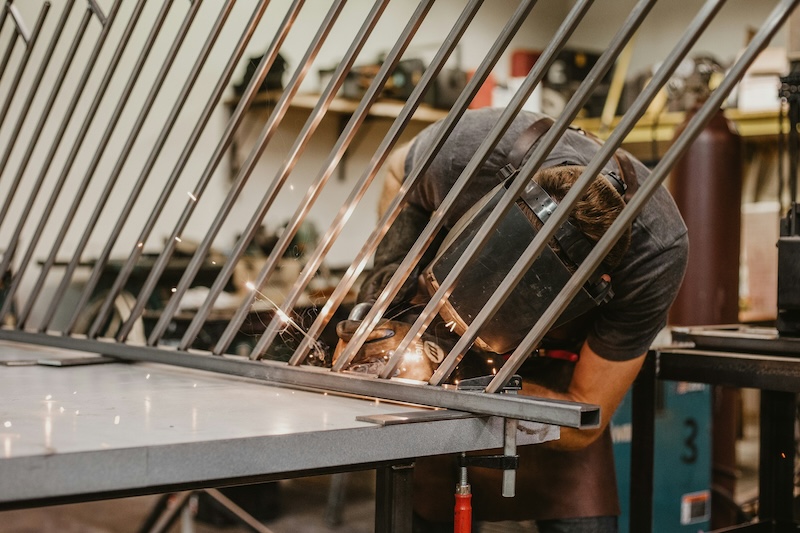
Welder Education Section
To land a job as a welder, you do not need a college degree. However, post-school certifications, learning programs, and training courses completed throughout your career show recruiters and hiring managers that you are an avid learner of your trade. It also provided credibility in terms of your technical knowledge.
The more credentials you can offer prospective employers, the better your chances of securing higher-paying positions. In short, list the What, Where, and When regarding your qualifications and certifications: date completed, hours accumulated (if applicable), level attained, institution attended, and location.
This section include vocational welding programs, apprenticeships, or certifications from organizations such as the American Welding Society (AWS) or the National Center for Construction Education and Research (NCCER). Be sure to include the name of the institution, dates of attendance, and any relevant degrees or certifications earned.
Examples:
2017 – CNC Machine Tool Operator Certificate Lincoln Tech, Denver, CO
2016 – Associate of Applied Science in Welding Technology, Coral Springs University, CO
Course Curriculum:
Metallurgy, Design, Schematics, Materials Science, Materials Processing
2016 – Certified Welder, American Welding Society, Doral, FL
2015 – Certified Underwater Welder, American Welding Society, Doral, FL
2014 – Certified Commercial Diver, American Red Cross, Washington DC
2014 – Advanced First Aid Certificate, American Red Cross, Orlando, FL
Resume Skills
Technical adeptness, physical traits and interpersonal skills are equally crucial for Welders to perform their jobs successfully. Therefore, ensure that you include examples of all three in your Welder Resume Skills Section.
Presenting your competencies in a Skills Matrix format will reinforce your message that you would be an excellent fit for the role that you applied to.
Skills & Competencies
| Physical Skills | Technical Skills | Interpersonal Skills |
|---|---|---|
| Manual Dexterity | Calculating Dimensions | Punctual |
| 20/20 Vision | Interpreting Sketches | Trustworthy |
| Hand/Eye Coordination | Cutting and Trimming | Communication |
| Multi-Limb Coordination | Molten Metal Flows | Detail Orientated |
| Endurance | Identifying Joints | Team Player |
| Ability to life 70 pounds | Part and Material Inspection | Energetic |
| Nimble & Agile | Safety Standards | Self-Managed |
| Depth Perception | 2D and 3D Diagrams | Determined |
| Peripheral Vision | Fixtures | Committed |
| Excellent Health | Arc Welding | Problem Solving |
Technology and Tools
| Fillet and Butt Weld Gauges | Lifting and Control Devices | Metal Finishers |
| Robotic Welding Equipment | Grinders | Soldering Iron |
| Brazing Torch | FCAW | MIG |
| SMAW | Weldshop | TIG |
| SmartDraw | MITCalc | Welded Connections |
Qualifications/Certifications associated with Welders
| OSHA Certification | GED | High School Diploma |
| Six Sigma Yellow Belt Certification | CNC Programmer Certification | CNC Welder-Milling |
| TIG - Gas Tungsten Arc Welding (GTAW) | Certified Associate Welding Inspector | Certified Welding Educator |
| Certified Welding Sales Representative | Energy Beam Welding (EBW) | Atomic Hydrogen Welding (AHW) |
| Flux-Cored Arc Welding (FCAW) | Gas Tungsten-Arc Welding | Plasma Arc Welding |
| MIG - Gas Metal Arc Welding (GMAW) | Stick - Shielded Metal Arc Welding (SMAW) | Certified Radiographic Interpreter |
Additional Sections
Your welding resume should now already be impressive, but standing out requires more than just the basics. As you will likely compete with other candidates, it's essential to fortify your resume with extra sections that showcase your diverse skills and experiences.
Consider incorporating the following additions to elevate your resume for welding jobs:
- Certifications: Highlight relevant certifications that demonstrate your expertise and commitment to professional development.
- Language Skills: Showcase any additional languages you speak fluently, as this can be advantageous in a multicultural work environment.
- Welding Projects: Illustrate your hands-on experience and creativity by including notable welding projects you've completed.
- Welding Licenses: Provide details of any licenses or qualifications you possess, further solidifying your credibility as a welder.
- Memberships: Mention memberships in professional organizations or industry associations to underscore your dedication to the welding profession.
- Hobbies and Interests: Offer insights into your personality and interests outside of work, showcasing a well-rounded individual.
- Volunteering Opportunities: Highlight any volunteer work related to welding or community involvement, demonstrating your commitment to making a positive impact.
By incorporating these additional sections into your welding resume, you can set yourself apart from the competition and position yourself as a well-rounded and accomplished candidate in the eyes of potential employers.
Tips for Success
- Tailor your resume or cv to the specific welding job you're applying for, highlighting the most relevant skills and experiences.
- Use keywords and action verbs relevant to the welding industry to help your resume stand out to ATS systems and recruiters.
- Proofread your resume carefully to ensure it's free of typos, grammatical errors, and formatting inconsistencies.
- Consider including a portfolio or samples of your welding work to further showcase your skills and expertise.
By following these tips and guidelines, you can craft a welder resume that effectively highlights your skills, experience, and qualifications, setting you apart from the competition in today's competitive job market.
